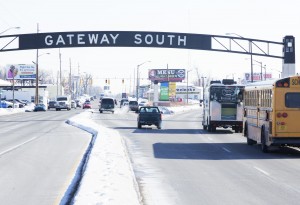After nearly four years of discussion among residents, business leaders and legislative and administrative bodies the proposed Madison Avenue Economic Development Area has been approved by the Indianapolis City-County Council. The EDA will stretch from South Street to County Line Road.

The recently approved Economic Development Area will span Madison Avenue from South Street to County Line Road, passing under the Gateway South Arch (above) where Madison Avenue and East Street split.
(Photo by Scott Mitchell)
The University of Indianapolis has advocated this proposal and will play key instrumental and influential roles in the continuing development of the area, according to Associate Vice President for Community Relations David Wantz.
“As a sustainable community anchor—that’s our vision—to be instrumental means that you have to spend money in the area,” Wantz said. “The fact that you’re able to sustain the economy because of your spending attracts businesses to the area.”
Wantz believes that the university can have millions of dollars’ worth of effects on the economy in goods and services alone.
In a column written for the Indianapolis Star UIndy President Rob Manuel said, “With its physical facilities, human and intellectual capital and $23 million in annual spending within Marion County, UIndy is uniquely positioned as a community anchor and catalyst for redevelopment, especially in the area bounded by Meridian Street and Interstates 65 and 465.”
However, Wantz said that UIndy is not an economic development corporation, so the university’s goal is not to create businesses but to attract businesses.
One way the university is doing that is through the Homestead Program. Wantz described this program as an attempt to bring faculty and staff to live in the area by giving them a forgivable loan to buy a house near the university. Influential roles are also very important in the university’s part in the development process, according to Wantz.
“When organizations need some help with research, some help with leadership or organization, we can provide that kind of help. We helped to found the Gateway Business Alliance. We helped with a group south of here called the Interurban Trail. We’re tied into other neighborhood and business organizations as a way of saying, ‘If you need to find the front door of the university, if you need to work with the university, here’s how you do that,’” Wantz said.
The university also has plans to start a new health center for the University Heights area. This health center, according to Wantz will meet a health need in the area. The university thinks that it can serve the people in the community, give students a chance to learn and create new academic programs through the creation of this new program.
Mayor Greg Ballard announced in his State of the City address delivered at UIndy on Feb. 27 that Indianapolis will give a $1 million dollar endowment to further this project. The theme of Ballard’s address was “Live Indy.”
According to Wantz, Indianapolis is a destination where too many people visit and too few people live.
Manuel announced the health center and other aspects of the university’s five-year, $50 million dollar plan in an email to students and faculty on Feb. 20.
“All these commuters that are coming to town, they get police, fire, road service, all of that, but they don’t pay for it through their taxes. The mayor needs 50,000 people making $50,000 dollars to move back in to town,” Wantz said. “How do you do that? You have to have neighborhoods that work, you have to have anchors that are driving and you have to have this unified vision that we’re all on the same page to make it work here.”
This focused effort toward development will work, according to Wantz, because there are people here who want to make a difference in their community. Residents and business leaders are willing to dig in their feet and prevent this teetering community from falling, he said.
According to Wantz, it is commonly said, that “all the good stuff happens up north.” Wantz, however, believes this statement is not true anymore.
“It’s our intention,” he said, “to make this a destination where people want to live, work and play.”






